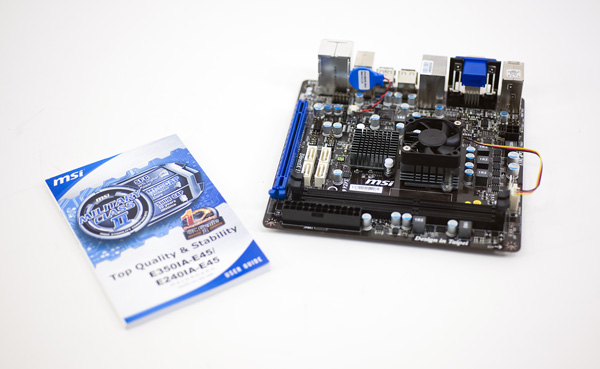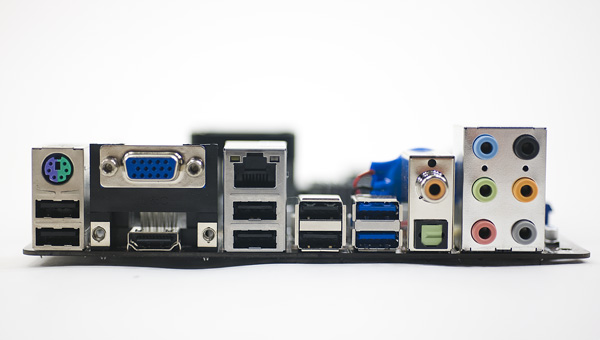The Brazos Review: AMD's E-350 Supplants ION for mini-ITX
by Anand Lal Shimpi on January 27, 2011 6:08 PM ESTThe Price: Around $100, The Motherboard: MSI's E350IA-E45
AMD expects most E-350 motherboards to sell for around $100 in etail. For lightly featured boards, I've heard this estimate is about right. It's once you start adding WiFi, passive cooling and other enhancements that costs creep up to around $130. Even at $130 that's not a bad deal. We're talking about better pricing than most ION boards but with much better performance.
AMD sent over the first Brazos motherboard ready for prime time, MSI's E350IA-E45. The mini-ITX board features two DDR3 DIMM slots (a Brazos feature, there's still only one 64-bit memory channel off of the APU), four 6Gbps SATA ports and a PCIe x16 slot (electrically x4). On the I/O panel MSI provides both VGA and HDMI out for video. For audio you have the options of running audio over HDMI, coax, optical or 1/8" stereo outputs. There are a surprising number of USB ports on the back of the board: 6 x USB 2.0 and 2 x USB 3.0 driven off of the very familiar NEC D7202 USB 3.0 controller. There are two USB 2.0 headers for front panel or case USB as well. There's unfortunately no WiFi support on board, all you get is a single Realtek RTL8111D 10/100/1000 ethernet port.

mini-ITX motherboard (right) and mini-ITX manual (left)
The MSI board doesn't support overclocking, so all results are at the CPU's stock 1.6GHz frequency.
Power is supplied by a standard 24-pin ATX PSU connector (older Atom/ION boards sometimes only used a 20-pin connector) as well as a 4-pin ATX12V connector. The Hudson FCH is passively cooled while the APU features a small, and unfortunately audible fan. ASUS is working on a passively cooled E-350 motherboard which I should have within the next week.























176 Comments
View All Comments
nitrousoxide - Thursday, January 27, 2011 - link
That's cool. When Intel owned everything, try buy a Core i5 with $200 as today. Actually, I'm not quite sure if an i3 will cost less than $150.And that's what happened during G80 era. nVidia has the best GPU, much much faster while the R600s are craps, ATI's on the edge of extinction. See what you got? $1000 for the flag-ship 8800 Ultra, $600 for a high-end 8800GTX. A decent card may cost you $400 (8800GTS) and even a crappy (though not as slow as Radeon 2600) 8600GT costs you $250.
Enlightenment777 - Thursday, January 27, 2011 - link
Rumors, Rumors, Rumors, Reviews, Reviews, Reviews, when can we buy E-350 motherboards from NewEgg?GTaudiophile - Thursday, January 27, 2011 - link
What are the differences between high- and low-end HTPCs?I am thinking of making a combo HTPC/NAS box of sorts...playing the role of both media streamer (online content, mkvs, etc.) as well as a storage box for machines on the network.
Will this do it? With what OS?
djfourmoney - Thursday, January 27, 2011 - link
Go to the AVS Forums and look at Rene's HTPC Guide, the latest version is $10 but well-worth it.Low End HTPC especially AMD in recent years rely on IGP for all video decoding. But this equals the performance of a 785/880 based CPU/Chipset combo and cost about 25% less, less than half the power needed and tiny footprint.
Unless you need expansion slots, as I said this thing can be built for such a low price you should replace your standard def Cable Box with this. Even with a PCIe Tuner Card that read Clear QAM as most do, it will pay for itself (no box rental fee) in about a year if not less.
You can not buy a i3 for less than the whole board. In fact for the price of a i3, you can get the Asus with Wifi, Bluetooth and Heat Pipe cooling which is going for 141 Euro listed on European sites. It should cost roughly the same in the States some sources have it coming in around $150.
Even if that's the case if you don't need USB 3.0 or SATA 3.0, the ASRock and Jetway boards will be the cheapest and think should be under $100 street price.
Too bad AMD's current drivers don't support HDMI Audio for Linux installs. If they ever solve that, then you really can build a sub-$325 with all brand new parts.
Just to fully answer your question, a high end HTPC depending on your desires, will have a Core i5 or AMD Phenom II CPU and Mid Range Video Card (HD5770) for some post-processing and 7.1 over HDMI. You can do that or a $200 Asus Xonar card, the GPU is cheaper and will do the same thing...
Cost would be roughly twice that of a Atom/ION or AMD E350 system ($500-$700)
Would be Windows 7 with Media Center if you want DVR capabilities or you can run XMBC strictly for media playback or Mediaportal.
As I said Linux drivers for AMD hardware does not support audio over HDMI, so you would have to go with Toslink.
GTaudiophile - Thursday, January 27, 2011 - link
Thanks for the reply.I meant high- vs. low-end more in terms of capability? What more can I do with the high-end vs. low? Can a Zacate-based HTPC, armed with 2x 2TB HDDs in RAID 1 stream 1080p from say Netflix and play the 720p mkv episodes of TOP GEAR, smoothly? And when not streaming it will be a locally networked storage array.
You think Win7 is the best? I currently run FreeNAS now for my NAS...why do I feel like Win7 would be some sort of downgrade?
Anand Lal Shimpi - Thursday, January 27, 2011 - link
High vs. Low mostly has to do with the responsiveness of the machine more than anything else (for a purely dedicated HTPC). Remember that only video decode is fixed function hardware assisted, everything else (launching apps, navigating around menus, general use stuff) is still run on the CPU core - which in this case may be around the performance of a 2.66GHz Pentium 4 depending on the workload.A higher end HTPC can also be multifunction (e.g. do your ripping, transcoding and watching on the same machine).
Take care,
Anand
tecknurd - Friday, January 28, 2011 - link
I disagree. A low end processor can still be as responsive as a high end processor. The difference between a low end and a high end processor depends on how much work you want to do with the processor. Also it depends on how long it takes a re-encoding or any task to be done. A low processor can do two things if they both consume 50% of CPU usage. One of the tasks could be video playback and other is re-encoding a video. The re-encoding will take longer than a high-end processor.Responsiveness is how the user interface software is written. Using a high end processor with a user interface that is slow will not help the responsiveness of the whole setup.
A example of a low end and a high processor is a computer nerd and muscle builder pounding as many nails in a wood. The muscle builder is able to pound more nails than the computer nerd. Another test is pulling an airliner and again the muscle builder is able to move it. In this example shows that bigger muscles helps to do the heavy lifting, but the efficiency of the smaller muscles of the computer nerd uses less energy although it takes more time.
zodiacfml - Friday, January 28, 2011 - link
he refers the system as DVR or HTPC, not just a file server which most will do with Brazos.tecknurd - Friday, January 28, 2011 - link
Digital audio over HDMI does work in Linux including for AMD hardware, so I do not where you are getting your information. Getting digital audio to work in Linux is a whole different matter all to its self. This goes for any hardware. It is best to use analog output for ease of setup.Do not need a $200 Xonar card. A $90 Xonar is all you need although the only times you need this card is its analog audio capabilities.
An Athlon II is a better buy for a HTPC than a Phenom II.
The problem using AMD graphic cards in Linux is no video codec hardware acceleration support. Sure there is some, but the short list and its problems makes it has no support. AMD graphic users have to wait until the Xorg team provides VA API or UVD support.
FYI, ASRock does not have a warranty for end-users, so you have to rely on the store wherever you bought it from. Jetway may seem cheap, but their support is not good.
djfourmoney - Thursday, January 27, 2011 - link
I was thinking the same thing -You can build a Server with MSI or Gigabyte because those will be the cheapest SATA 3.0 boards. Maybe 12TB (6 SATA ports x 2TB@90 each) plus case and E350, about $800? I found a mITX Server Case that holds
Get a Sapphire Pure White Fusion which has Bluetooth and 2nd PCIe x1 slot.
Go Powerline Ethernet, 60GB Kingston SSD, Windows 7 and Windows Home Server with Recorded TV Manager an uTorrent Plug-in.
Turn your old PC into a Workstation for Ripping Blu-Ray and Encoding.